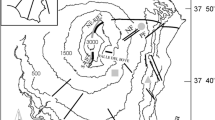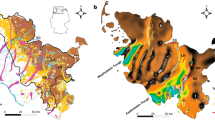Abstract
This article delves into the factors that may influence radon flux, such as soil properties and weather conditions, on the example of two experimental locations with different soil compositions, composed primarily of clay and sand, respectively. The experimental location with sandy soil was previously observed to have anomalously high radon flux levels. Radon monitoring was performed routinely, approximately at the same time of day and in parallel on both of these locations to exclude the influence of diurnal variations. The results show that radon transport in these locations differs in mechanism: Location with clay soil has diffusive radon transport, with an average radon flux density of 37.4 ± 24.9 mBq m−2 s−1 and a range of 0.3–167.8 mBq m−2 s−1, while the location with sandy soil has convective radon transport with an average radon flux density of 93.6 ± 51.2 mBq m−2 s−1 and a range of 9.8–302.2 mBq m−2 s−1. This corresponds to about 8.3% of RFD measurements on site with clay soils exceeding the national reference level of 80 mBq m−2 s−1 and 45.6% exceeding them on the site with sandy soils. Average radon flux density values were then compared to meteorological variables using Pearson correlation analysis with Student’s t-test. It was observed that radon flux density correlates the most with ambient air temperature both for diffusive and convective radon transport mechanisms, while a weaker inverse correlation is observed with atmospheric precipitation and wind speed for the diffusive mode of radon transport, but not for the convective. Radon activity concentration in soil air correlates with the radon flux density and air temperature in the case of convective radon transport, but does not correlate in the case of diffusive transport.










Similar content being viewed by others
Data availability
The datasets generated during and/or analyzed during the current study are available from the corresponding author on reasonable request.
References
Arvela H, Voutilainen A, Honkamaa T, Rosenberg A (1994) High indoor radon variations and the thermal behavior of eskers. Health Phys 67(3):254–260. https://doi.org/10.1097/00004032-199409000-00005
Chauhan RP, Nain M, Kant K (2008) Radon diffusion studies through some building materials: effect of grain size. Radiat Meas 43. https://doi.org/10.1016/j.radmeas.2008.03.013
Darby S et al (2004) Radon in homes and risk of lung cancer: collaborative analysis of individual data from 13 European case-control studies. BMJ 330(7485):223. https://doi.org/10.1136/bmj.38308.477650.63
Federal Center of Hygiene and Epidemiology of Rospotrebnadzor (2010) Basic sanitary rules for radiation safety (OSPORB – 99/2010). Sanitary-epidemiological rules and standards, SP 2.6.1.2612–10. Moscow, 83 p. (In Russian)
Ferry C, Beneito A, Richon P, Robe MC (2001) An automatic device for measuring the effect of meteorological factors on radon-222 flux from soils on the long term. Radiat Prot Dosimetry 93(3):271–274. https://doi.org/10.1093/oxfordjournals.rpd.a006439
ICRP (2014) Radiological protection against radon exposure (No. 126). https://www.icrp.org/publication.asp?id=ICRP%20Publication%20126. Accessed 15 Apr 2022
Iskandar D, Yamazawa H, Iida T (2004) Quantification of the dependency of radon emanation power on soil temperature. Appl Radiat Isot 60(6):971–973. https://doi.org/10.1016/j.apradiso.2004.02.003
Kovler K, Perevalov A, Steiner V, Metzger LA (2005) Radon exhalation of cementitious materials made with coal fly ash: part 1 – scientific background and testing of the cement and Fly Ash Emanation. J Environ Radioact 82(3):321–334. https://doi.org/10.1016/j.jenvrad.2005.02.004
Lefebvre R, Lahmira B, Löbner W (2019) Atmospheric control of radon emissions from a waste rock dump. Environmental Geotechnics 6(6):381–392. https://doi.org/10.1680/jenge.15.00066
Miklyaev P, Makarov V, Dorozhko A, Petrova T, Marenniy M, Marenniy A, Makeev V (2013) Radon field of Moscow Geoecology. Engineering Geology Hydrogeology Geocryology 2:172–187 ((In Russian))
Miklyaev P, Petrova T, Marennyy A, Shchitov D, Sidyakin P, Murzabekov M, Lopatin M (2020) High seasonal variations of the radon exhalation from soil surface in the fault zones (Baikal and North Caucasus regions). J Environ Radioact 219:106271. https://doi.org/10.1016/j.jenvrad.2020.106271
Miklyaev P, Petrova T, Shchitov D, Sidyakin P, Murzabekov M, Marennyy A, Nefedov N, Sapozhnikov Y (2021) The results of long-term simultaneous measurements of radon exhalation rate, radon concentrations in soil gas and groundwater in the fault zone. Appl Radiat Isot 167:109460. https://doi.org/10.1016/j.apradiso.2020.109460
Nazaroff WW (1992) Radon transport from soil to air. Rev Geophys 30(2):137. https://doi.org/10.1029/92rg00055
Raspisaniye Pogodi Ltd. (2022) RP5.RU Weather archive in Moscow (Balchug). https://rp5.ru/Weather_archive_in_Moscow_(Balchug). Accessed 15 Apr 2022
Sahoo B, Mayya Y, Sapra B, Gaware J, Banerjee K, Kushwaha H (2010) Radon exhalation studies in an Indian uranium tailings pile. Radiat Meas 45(2):237–241. https://doi.org/10.1016/j.radmeas.2010.01.008
Schumann RR, Owen DE, Asher-Bolinder S (1992) Effects of weather and soil characteristics on temporal variations in soil-gas radon concentrations. // Geological Society of America. V. 271
STC “NITON” (1993) Method for measuring radon flux density from the surface of the soil and construction materials
Stranden E, Kolstad A, Lind B (1984) The influence of moisture and temperature on radon exhalation. Radiat Prot Dosimetry 7(1–4):55–58. https://doi.org/10.1093/rpd/7.1-4.55
Trofimov V, Korolev V (1993) Practical work in soil science Lomonosov MSU 390 p. (In Russian)
UNSCEAR (2000) Sources and effects of ionizing radiation (No. 1). https://www.unscear.org/unscear/en/publications/2000_1.html. Accessed 15 Apr 2022
World Health Organization & World Health Organization (2009) WHO Handbook on Indoor Radon. World Health Organization
Yakovleva V. Radon transport processes in non-equilibrium media Dissertation abstract for the doctorate degree Tomsk Polytechnical University (2002) (In Russian)
Yang J, Buchsteiner M, Salvamoser J, Irlinger J, Guo Q, Tschiersch J (2017) Radon exhalation from soil and its dependence from environmental parameters. Radiat Prot Dosimetry 177(1–2):21–25. https://doi.org/10.1093/rpd/ncx165
Author information
Authors and Affiliations
Contributions
Sakhayaan Gavriliev carried out the experiment and wrote the manuscript with support from Tatiana Petrova and Petr Miklyaev. Tatiana Petrova supervised the project. Tatiana Petrova and Petr Miklyaev provided the equipment for the project.
Corresponding author
Ethics declarations
Ethics approval and consent to participate
Not applicable.
Competing interests
The authors declare no competing interests.
Additional information
Responsible Editor: Georg Steinhauser
Publisher's note
Springer Nature remains neutral with regard to jurisdictional claims in published maps and institutional affiliations.
Supplementary Information
Below is the link to the electronic supplementary material.
Rights and permissions
About this article
Cite this article
Gavriliev, S., Petrova, T. & Miklyaev, P. Factors influencing radon transport in the soils of Moscow. Environ Sci Pollut Res 29, 88606–88617 (2022). https://doi.org/10.1007/s11356-022-21919-y
Received:
Accepted:
Published:
Issue Date:
DOI: https://doi.org/10.1007/s11356-022-21919-y




